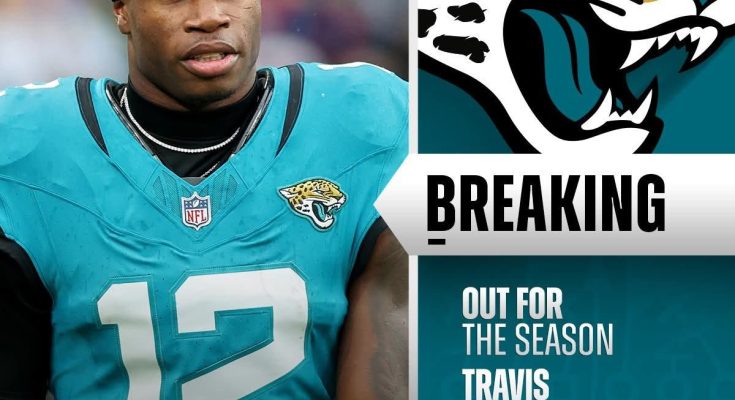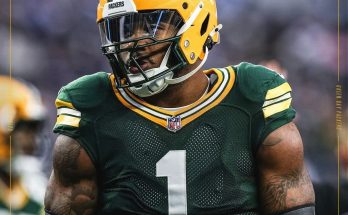Travis Hunter’s 2025 rookie season with the Jacksonville Jaguars has come to an abrupt and painful end after he underwent season‑ending knee surgery. The two‑way star — playing as both a wide receiver and a cornerback — had surgery to repair a torn lateral collateral ligament in his right knee, and while the good news is that there was no additional structural damage, the reality is that he will miss the rest of the year.
Hunter suffered the injury during a practice session on October 30 in what was described as a non-contact incident. The Jaguars initially placed him on injured reserve, holding out hope for a relatively short-term recovery. But after further medical evaluation, the team determined that surgery was necessary. The procedure was carried out in Dallas by Dr. Dan Cooper and the Jaguars’ team physician, Dr. Kevin Kaplan.
According to the Jaguars’ official announcement, the injury was isolated to the LCL, with no other ligaments or structures in the knee affected. That’s a major relief in some sense — no ACL tear, no meniscus damage, no complicated multi-ligament reconstruction. But even an isolated LCL repair comes with a significant recovery timeline, especially for a young athlete whose body will be pushed to return to top form. The team projects that Hunter will be back to full football activities in about six months, which means he could realistically return in time for the start of the 2026 season.
This is a brutal blow for both Hunter personally and the Jaguars as a franchise. As the No. 2 overall pick in the 2025 NFL Draft, Hunter was heralded as a rare two-way talent. The Jags actually traded up — giving up their 2025 second-rounder and a 2026 first-round pick — to draft him, counting on his dynamic athletcism, his ability to contribute on offense and defense, and his potential to become a cornerstone player.
In the seven games he played this season, Hunter showed flashes of what made him so coveted. On offense, he logged 28 receptions on 45 targets, racking up 298 yards and scoring his first NFL touchdown. (NFL.com) He saw a majority of offensive snaps, reportedly participating in 67 percent of them. (NBC Sports) On defense, he wasn’t just a token presence; he played in 36 percent of the defensive snaps, notching 15 tackles and breaking up three passes. (NFL.com)
Perhaps his most promising performance came in Week 7 against the Los Angeles Rams in London, where he made eight catches for 101 yards and hauled in his first touchdown. (NFL.com) That game raised expectations that the Jaguars would lean more heavily on him on offense moving forward, especially as they belt out a long-term plan around his rare two-way skill set.
Now, with him down for the season, the Jaguars are forced to rethink how they move forward in the short term. Other receivers will have to step up — and they already seemed to be preparing for that. The team recently acquired veteran Jakobi Meyers, giving them a more dependable option in the receiver room, especially with Hunter unavailable.Parker Washington is another player who is expected to carry more of the load in Hunter’s absence.
Coach Liam Coen and the Jaguars’ front office also face a deeper question about Hunter’s long-term role. Before the injury, they envisioned him as a timeless two-way star — someone who could contribute significantly on both offense and defense. But with this injury, and the uncertainty about how his knee will respond, the coaching staff might reconsider whether that’s the best path forward. Coen has indicated they’ll review Hunter’s future roles at season’s end, evaluating what he did well, where he needs to improve, and how they can deploy him most effectively.
In terms of recovery, the prognosis is cautiously optimistic. The fact that the injury was isolated to the LCL and that no further damage was found is a strong factor in his favor.But six months of recovery doesn’t mean he’ll be back at 100 percent immediately — he’ll likely go through a structured rehab program, gradually reintroducing football activities under the care of medical and training staff. The timeline suggests that he could be ready by next season, but the Jags will likely be careful not to rush him, given how valuable he is.
For Hunter himself, the timing is especially cruel. He’s just 22, a rookie with sky-high expectations and a huge role already, and he was starting to find footing. Instead, he goes into recovery mode at a critical juncture, facing the mental and physical challenge of rehabbing a significant ligament injury. But there’s also a flip side: this is an opportunity for him to come back stronger, learn from the setback, and potentially refine how he plays — maybe focusing on one side of the ball if that’s safer for his long-term health, or growing into a more nuanced two-way role when he returns.
From the Jaguars’ perspective, this injury raises real concerns not just for 2025 but for the framing of their future. They risk having invested a lot to acquire a dynamic but fragile two-way talent — and now must balance their commitment to him with the need to win now. The decision-making during his recovery will matter: how aggressively they rehab him, how they test his two-way capability after surgery, and whether they retain a plan to use him on both sides of the ball.
The emotional toll on the team and the fans is also significant. There was real excitement around Hunter. Not just because of his rare athletic profile, but because he embodied a kind of generational talent — a player who could change games in two phases, who could be a foundational piece. To lose that for the season is a gut punch.
Yet, there’s room for cautious optimism. Modern surgical techniques, combined with quality medical care, make returns from isolated LCL injuries quite plausible. If all goes well, Hunter could be back healthy, ready to pick up where he left off — maybe even more polished than before. And if the Jaguars manage his recovery well, he could fulfill that two-way promise that made him such a coveted pick in the first place.
This surgery brings uncertainty, no doubt. But it doesn’t erase the talent, the upside, or the belief that Hunter can be a cornerstone. It just means the journey will be longer, bumpier, and more complex than anyone hoped at the start of the season. And while 2025 ends now for him, the real test will be how he comes back — how he rehabilitates, how he reearns the trust of the team, and how he claims his role again, whether with a single focus or on both sides of the ball.



